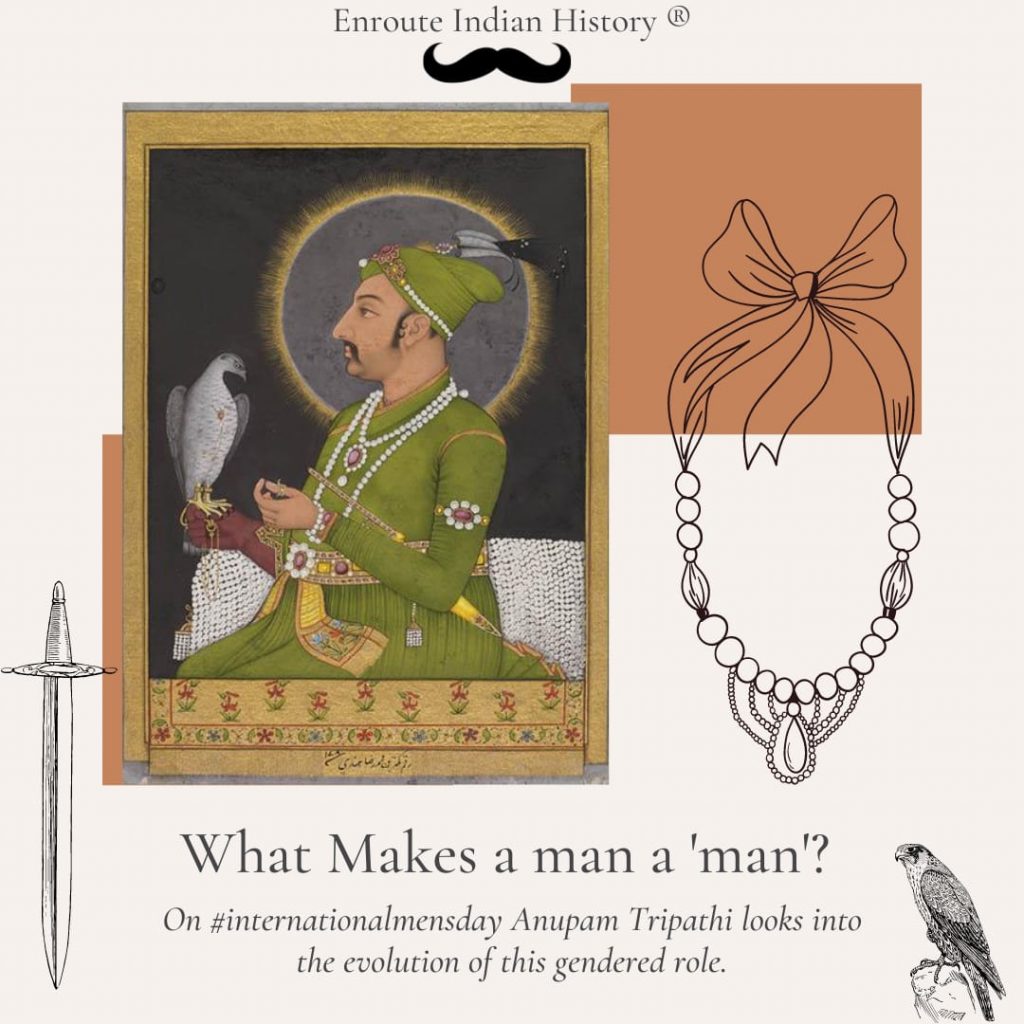
Article by EIH Researcher and Writer
Anupam Tripathi
“It is not what he has, or even what he does which expresses the worth of a man, but what he is.”
~ Henri Frederic Amiel.
‘Be a man!’, a phrase every man in the world must have heard or will hear one day or another. What makes a man a man? One thing is clear: being born in a particular gender does not necessarily make a man he is meant to be. One has to follow certain rules and regulations in order to become a man in the truest sense of the word.Masculinity encompasses that aspect of the man that gives him recognition of his identity and defines his relationship with other men.
Nasir al-Din Tusiin Akhlaq-iNasiri argued that it was important for a man to have a house because it protected him, it helped him to save resources from other beings, since everyone tried to survive with the help of these resources. House was not just a closed room made of stone bricks; it was a space in which man lived with his company. House consisted of five things: husband, wife, child, servants, and livelihood.1Husband was the owner of his house. For better understanding, Tusi compared the man to a shepherd who tends his flock, saying that the man had to be courteous while being expected to make tough decisions and criticize his company when things went wrong. The union of man and woman was of begotten and begetter; one served and servant.2
To become the man one had to look after the welfare of all family members like a doctor. If that welfare required separation from a family member, the man should not back out. He was someone who knew the nature of every member of his family and tried to keep his balance. A good man was expected to win by fair means; not at the expense of others through meanness or deception. In Tusi’s understanding, charity was paramount. He must always be ready to help others and shouldn’t spend money on unimportant things. Intelligent was a man who stored everything his household needed at the time of need.
Tusi gave the man a great responsibility to regulate his wife and punish her for everything she did wrong. According to him, the woman was the deputy in the absence of the man. She was expected to look after her husband’s property, home, and other members. She was expected to submit to and obey her husband completely. She had to be intelligent, fertile, and virgin.The man was advised to
rule his wife; it was the man’s responsibility to keep his wife veiled and secluded. Veiling and segregation were also common in later periods, such as the Mughal era, in the form of the harem. We must understandthat imperial women were segregated, but that segregation did not mean seclusion. The Woman was allowed to participate in household discussions by her husband as long as she did not consider herself mistress of the house. The man was advised to keep an eye on his wife and make sure that she focused on the tasks assigned to her. It was the husband’s responsibility to keep hiswife busy at home. If not, she could create a mess. He was advised not to love her excessively.
Noble men should not pay attention to clothesbecause colourful and embroidered clothes were not for men. Appetite was another aspect of being a man. Liking or craving various food items was not appreciated by Tusi. How one behaved in the presence of others was an important aspect of being the good man in his eyes. He advised men to let others speak. He believed that the good man would concentrate more on listening than on speaking. He didn’t have to show his intelligence and be more concerned with listening than speaking. One had to keep in mind the superiority of others when speaking in an assembly. He was sceptical of using a lot of gestures while speaking. He said that the subject of discussion should revolve exclusively around the assembly.
Tusi said that men should not walk too fast or too slow. He should not strut or move his shoulders, like women or effeminate men. While sitting, feet should not be placed on one another (this draws our attention to another important aspect of norms of manliness formulated by Akbar around man’s body). Man was allowed to kneel down only in front of master, kings, and father. It was very important, according to him, how the men dressed. He said that men should dress according to his rank and maintain the social hierarchy. He is expected to cover his entire body except his face and hands. He must follow certain courtesies while eating in an assembly, such as waiting for everyone else to finish before getting up, stop eating and getting up once everyone was done eating.
He said that a good man was a ‘city dweller’. He needed help of other species and co-operation of his kind to survive. It was with the help of others that he regulated his livelihood. In order to attain self-perfection, man needed others because there was a need for synthesis to attain perfection. He argued that some men desired pleasure out of that synthesis, but only good man desiredlove.
The perfection of man could only be achieved through admiration and worship of the divinity, with a social organization in which everyone earned money. The good man would always re-evaluate his behaviour and the level of natural goodness. It gave us an idea of what men should do and how they should have behaved in the 13th century. His understanding of man began at an individual level where he was seen as a rational being, different from all other beings, but at the same time, man needed others to become the perfect man he was supposed to be. He needed to regulate not only himself but also several people around him, especially his company around the house. He makes us understand that a man was only good when he was not only aware of the things that were happening in his family but also around him. What he meant was that man must know where he stood in the social hierarchy and act accordingly.
The understanding of being a man took a different turn in the 15th century when Baburformulated norms of manliness. These norms were appropriated for a warrior king, but we can use these norms to paint a bigger picture for understanding the basicunderstanding of manliness. Organization and regulation of the household were no longer essential. Manliness now revolved around different things5:
- exerting violence,
- withstanding violence or hardship
- knowing the appropriate time for withholding violence, and
- politics of sexuality
The lack of aggressiveness and courage was considered unmanly. Ali Anooshahr points out that “unmanly” had nothing to do with the effeminacy of men, as there were no obvious concepts of binaries in the texts of the medieval period. He believes binary to be a modern concept. One of the commonalities between Tusi’s understanding of manliness and the norms of manliness during Babur revolved around the use of sexuality for pleasure; they both thought it was wrong. He followed the same standards regarding gender and sexuality that he wanted his warriors to follow. He was trying to set an example for his warriors, but Humayun didn’t believe it. We note a distinction between Babur and Humayun’s interpretation of the norms of manliness. Babur, on the one hand, saw no significant difference between himself and his warriors when it came to following norms around gender roles and sexuality, Humayun, on the other hand, marked a stark contrast between himand his warriors. We don’t notice any significant change in the 16th century in terms of viewing women as property that had to be conquered, tamed, and domesticated by a righteous ruler.
It is undeniable that the 16th century saw a transition. This transition was evident in different spheres of the century and one of those spheres was that of gender roles and sexuality. Akbar was introduced as the insan-ikamil or the perfect man in Ab’ulFazl’s famous work,Ain-i Akbari. He and his associates drew on a careful selection of Akhlaqi themes to build a more inclusive model of male virtues transcending any religion, caste and region.6
This model focused not only on the inner purity of the male body, but also on the possibilities that would make men perfect. Akbar’s idea of manhood was heavily influenced by Tusi. authority over their families as husbands and righteous leaders. The standards of manhood have changed since Babur’s time, but to project himself as a perfect example was a legacy Akbar inherited from Babur. He was not only a father figure to his subjects, but also an active householder who had full commander over his body.7
Akbar made it compulsory to read Tusi’sAkhlaq-iNasiri, parts of Ghazali’sKimiya-iSa’adat and Rumi’s Sufi poems, as pointed out by MuzzafarAlam. He emphasized the importance of family and to keep the family intact he also regulated the extramarital pleasures of his Imperial servants. He did not forbid it, but only kept a watchon the extramarital pleasures of his imperial servants. Imperial service was becoming a means of improving human nature. He redefined masculine qualities by cutting his hair and shaving his beard. This in Akbar’s understanding heightened the masculine qualities. He advised shaving the beard to save the sperm. Semen became animportant aspect of manhood.It was considered pure and was considered the origin of all that was good.8 Akbar advocated for a pure spiritual male body. He discouraged homosexual conducts because it contaminated the body and the soul. He went so far as to punish those who were engaged in “homosexual love” (although “homosexual” is an anachronistic modernist term).
In order to protect the family, he established several regulations that kept women in line with the ideals of marriage. He promulgated that sexual activity for women was limited to procreation only. This is why younger men could not marry older women. The wife was to offer complete obedience to her husband. It was necessary for the woman to stay inside to protect the family. Akbar even punished the women who tried to disturb the peace in the house. Rosalind O’Hanlon maintains that the Mughal effort was to project manhood as a monopoly of imperial service. However, this model weakened over time and gave way to a new model, different from the previous one but to some extent similar. Muhammad Baqir in Mau’zah-iJahangiri spoke of the qualities of adab, which were to be cultivated in imperial servants by the emperor. He argued that it was necessary to embark on a journey to become an ideal man or Mard9.Man had to make many compromises to become the ideal man. New codes of masculinity emerged in the 17th century as new court culture developed in which consumption and display were indicators of authority. The old ethic of service and obligation lost its meaning, and Akbar’s model of the imperial servant as a representative of ideal masculinity was also fractured. A new concept of the man as a sophisticated gentleman emerged. It happened due to the spread of an urban culture of pleasure in the imperial capital. Men were now expected to become mirza (gentleman). Hanuman was no longer an ideal man, now Lord Krishna became the definition of the ideal man.
During the 19th– 20thcentury, the concept of what characterized a man evolved. RamaswamyPeriyar in “KudiArasu” argues that masculinity is an expression of male power and this expression created obstacles to women’s freedom and tied them to the chains of patriarchy. Ashish Nandi argues that colonial discourse portrays empire as masculine and India as effeminate. With this analogy, it is quite easy to tell the difference between the sexes. However, Charu Gupta argues that Nandi celebrated the pre-colonial indigenous past as being more tolerant, which had gender implications. Manhood acquired a more saffron colour, as the popularity of Hindu nationalism grew. In addition to fighting for the freedom of the homeland, we find that gender rolesacquired a religious touch. Muslim men were described as brute in the popular arena.They were seen as a threat to the Hindu nationalism. This is something that has continued until today. This brings me to the understanding of what made a man a man in 19th – 20th century. It was now self control, being modern, deeply attached to the household and ready to fight for motherland and religion.
Attachment to family is one of those aspects of manhood that continues to this day. The religious colour of masculinity took an aggressive turn in the form of uprisings that took place in contemporary times, such as Hindu- Sikh riot in 1984, Gujarat riots 2002, Exodus of Kashmiri Pandits 1990, etc.
Itdid not take a few years for masculinity to gain religious fervour; it took years and centuries for man to become aggressive and fanatic to protect himself, his nation and his religion. In simpler terms, the evolution of norms concerning manliness has gone through several stages. It started with a search for being the ‘perfect man’, but then gradually focused on the individual qualities that would make him a gentleman, then the focus shifted to becoming a patriot and now, a nationalist.
CONCLUSION:
Masculinity in literal sense implies an idea that there is no single, fixed, natural, universal “masculinity” to which all men ought to aspire, but rather the multiple, plural, complex, and even contradictory male identities that exist across cultural and historical settings.
Answer to the question, what made a man a man will always be very vague. One can never put a finger on one thing and say that this is what made a man a man. From the days of al- Tusi to today, the understanding of what makes a man a man has continued to evolve. This understanding is on a wheel of continuous evolution. The thirteenth century man would not be “manly” enough for the sixteenth or nineteenth century people. This vagueness is due to the ambiguity of identities in medieval times. It was with the advent of Paper Raj that people acquired their compartmentalized identities. However, some aspects of manhood standards remained intact over time and one of those aspects was the importance of family and control over women. Was it necessary for people to formulate the standards for how a man should act, to talk about how he should not act? There may be a myriad of answers to this question, but the most common answer would revolve around women. Tusi explained how important it was for a man to take care of his family and control his wife, at the same time, control his wife.Akbar’s norms of masculinity have more or less worked in the same direction. These concepts have evolved over time and have taken on a different colour in modern India. With the struggle for independence and Hindu nationalism sinking into the ground, manhood took on a religious colour. Anyone who has spoken or formulated standards regarding manhood have used these standards to float their boats. But these standards bring us one step closer to understanding the society, politics and culture of the period in which these standards were formulated.
Taking everything into account, I conclude that Nasir al-in Tusi’s way of defining a man was one of the many ways that man could have been defined or projected. His understanding helps us paint a picture not only of how he wanted a man to be, but also helps us analyse the state of mind of a medieval scholar and how he perceived things around him. His akhlaq helps us understand the social history of the time from the perspective of a philosopher and scholar who understood society in association with a man and his struggle for perfection.
Notes
- Nasir al-Din Tusi, TheNasirean Ethics, George M. Wickens (London: Allen and Unwin, 1964), 25
- Ibid, 166
- Ibid, 218
- Ali Anooshahr, “The King Who Would Be Man: The Gender Roles of the Warrior King in Early Mughal History”, Journal of the Royal Asiatic Society 18, no. 3 (2008):328-329, https://www.jstor.org/stable/27755957
- Ibid, 340
- Rosalind O’Hanlon, “Kingdom, Household and Body History, Gender and Imperial Service under Akbar”, Modern Asian Studies 41, no. 5 (2007): 900, https://www.jstor.org/stable/4499806
- Ibid, 904-905
- Ibid, 914
- Rosalind O’Hanlon, “Manliness and Imperial Service in Mughal North India”, Journal of the Economic and Social History of the Orient 42, no. 1 (1999): 51-53, https://www.jstor.org/stable/3632298




















